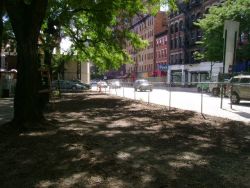Honey Locust Park
NYC PARKS, NYC DOT, NYC DEP UNVEIL $1.67 MILLION RENOVATION TO HONEY LOCUST PARK IN MIDTOWN EAST
Thursday, April 13, 2023
No. 20
http://www.nyc.gov/parks
Today, NYC Parks Commissioner Sue Donoghue joined NYC Department of Transportation Manhattan Borough Commissioner Ed Pincar, Department of Environmental Protection Deputy Chief Operating Officer Kim Cipriano, Manhattan Borough President Mark Levine, Assembly Member Alex Bores, Council Member Julie Menin, representatives from Community Boards 8 and 6, and community members to cut the ribbon on the reconstruction of Honey Locust Park.
“I’m excited to unveil the first renovation of Honey Locust Park in recent history,” said NYC Parks Commissioner Sue Donoghue. “Any expansion and reconstruction of open, green space is a win for New Yorkers, and we’re grateful to our sister agencies at DOT and DEP for working with us to make this a more welcoming space to sit, relax, and enjoy the shade.”
“Honey Locust Park provides much needed green space and tranquility at the foot of the Queensboro Bridge,” said NYC DOT Commissioner Ydanis Rodriguez. “The Adams Administration is reimagining the use of public space by making our roads more inviting for pedestrians and cyclists while ensuring access to maintain our infrastructure. DOT is thrilled to have partnered with Commissioner Donoghue and NYC Parks to make this project a reality.”
“DEP was proud to contribute $750,000 towards the refurbishment of Honey Locust Park, an important green space and oasis for the community,” said DEP Commissioner Rohit T. Aggarwala. “Importantly, this new version of the park will also absorb the stormwater that falls on it which will help to relieve localized flooding and improve the health of the East River.”
“This project is an excellent example of true agency coordination to improve and beautify our public spaces, and I want to commend Parks, DOT, and DEP for their collaboration”, said Chief Public Realm Officer Ya-Ting Liu. “The Adams Administration is committed to creating vibrant and attractive public spaces throughout the City, and this project is another step toward that goal.“
“Honey Locust Park gave a drab municipal equipment staging area a second life as a beautiful community gathering spot, and the modern reconstruction highlights the immense care and collaboration the City and the community have taken to continue improving the park,” said Manhattan Borough President Mark Levine. “Honey Locust Park perfectly embodies the paradox of New York City – this serene respite abuts and coexists with a major traffic artery. The value of this park to the community cannot be overstated.”
“Small parks dotting the neighborhood provide needed respite. This project took perseverance and creativity. I commend DOT, DEP, NYC Parks, and all of those who advocated for years to enable this remarkable refreshing of Honey Locust Park, which will be enjoyed by nearby families for generations,” said Assembly Member Alex Bores.
“As the Council Member representing one of the densest districts in New York City, the renovation of Honey Locust Park in Midtown East is critical for residents who live near this busy thoroughfare. The revitalization of this valuable parkland will welcome more of our neighbors as they access upgraded benches, plaza space and landscaping," said Council Member Julie Menin.
"Community Board 8 Manhattan is excited to welcome this park back into our neighborhood," said Russell Squire, Chair of CB8M. "This vital oasis will be a respite for members of our community in a neighborhood that needs more open space. The NYC Parks Department has done an exceptional job revitalizing this underutilized green space."
The reconstructed park now features benches, plaza space, pavements, landscaping, and water service, and allows DOT access to perform maintenance and repairs to the bridge when needed. The park provides a green space to soften the imposing nature of the bridge and surrounding traffic, and also provides the additional benefit of retaining stormwater within the property.
This $1.67 million project was funded by the Office of the Mayor, including $750,000 from DEP. Construction began in January 2022 and concluded in September 2022.
This park is under the jurisdiction of the Department of Transportation (DOT). In September 1938, DOT issued a permit to Parks that allowed indefinite use of the space as a public park. The park was informally called Gateway Park, possibly due to its proximity to the bridge roadway entrance, until it was formally named Honey Locust Park in 1996. For many years it was maintained by the community as a neighborhood garden and sitting area.
In 1980, Parks requested to extend the permit boundaries to include the entire block along 59th Street, between First and Second Avenues. The park was extended to its current boundary, though bridge maintenance, utility vehicle parking, and tunnel work necessitated continued joint occupancy of the site until the Department of Environmental Protection finished work in 2018.
Parks Commissioner Henry Stern formally named the site Fourteen Honey Locusts Park in October 1996, ostensibly after the Honey Locusts that stretched the city block. The name was ultimately shortened to Honey Locust Park in 2019.
The honey locust tree, originally restricted to the Mississippi Valley, is now found along the eastern coast. In its natural variety, it sprouts clusters of long thorns from its trunk. Cultivated varieties, however—like those in this park—have no thorns. The wood of the honey locust is heavy and durable, making it ideal material for railroad ties, fence posts, and agricultural implements. The honey locust’s fruit provides food for deer, rabbits, and squirrels.
Check out your park's Vital Signs
Clean & Safe
Green & Resilient
Empowered & Engaged Users
Share your feedback or learn more about how this park is part of a
Vital Park System



